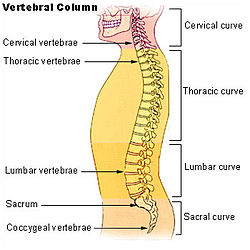Spinal column
| Vertebral column | |
|---|---|

The human vertebral column and its regions
|
|

Vertebral column of a goat
|
|
| Details | |
| Latin | Columna vertebralis |
|
Anatomical terminology
[]
|
|
The vertebral column, also known as the backbone or spine, is part of the axial skeleton. The vertebral column is the defining characteristic of a vertebrate, in which the (a flexible rod of uniform composition) found in all chordates has been replaced by a segmented series of bones—vertebrae separated by intervertebral discs. The vertebral column houses the spinal canal, a cavity that encloses and protects the spinal cord.
There are about 50,000 species of animals that have a vertebral column. The human vertebral column is one of the most-studied examples.
In the human vertebral column there are normally thirty-three vertebrae; the upper twenty-four are articulating and separated from each other by intervertebral discs, and the lower nine are fused in adults, five in the sacrum and four in the coccyx or tailbone. The articulating vertebrae are named according to their region of the spine. There are seven cervical vertebrae, twelve thoracic vertebrae and five lumbar vertebrae. The number of vertebrae in a region can vary but overall the number remains the same. The number of those in the cervical region however is only rarely changed.
There are ligaments extending the length of the column at the front and the back, and in between the vertebrae joining the spinous processes, the transverse processes and the vertebral laminae.
The vertebrae in the human vertebral column are divided into different regions, which correspond to the curves of the spinal column. The articulating vertebrae are named according to their region of the spine. Vertebrae in these regions are essentially alike, with minor variation. These regions are called the cervical spine, thoracic spine, lumbar spine, sacrum and coccyx. There are seven cervical vertebrae, twelve thoracic vertebrae and five lumbar vertebrae. The number of vertebrae in a region can vary but overall the number remains the same. The number of those in the cervical region however is only rarely changed. The vertebrae of the cervical, thoracic and lumbar spines are independent bones, and generally quite similar. The vertebrae of the sacrum and coccyx are usually fused and unable to move independently. Two special vertebrae are the atlas and axis, on which the head rests.
...
Wikipedia
